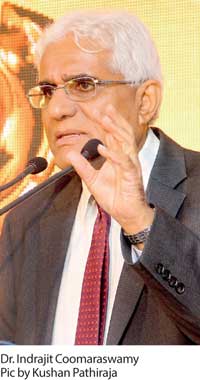12 Feb 2018 - {{hitsCtrl.values.hits}}
 The Central Bank recently said that the debt mismatch pointed out by the Auditor General may be at the provincial and local government levels, and that the Treasury is working to get a clearer sense of the debt in the general government books.
The Central Bank recently said that the debt mismatch pointed out by the Auditor General may be at the provincial and local government levels, and that the Treasury is working to get a clearer sense of the debt in the general government books.
“The central government debt, the state-owned enterprises debt and the contingency liabilities; those are well recorded. The general government debt at the provincial and local government levels; there I think there seems to be some challenges,” Central Bank Governor Dr. Indrajit Coomaraswamy told Mirror Business.
He said that the Attorney General may have been referring to debt in the books of the central government being transferred to the general government.
“Whether that is right or wrong, we don’t know,” Dr. Coomaraswamy said.
He said that the Central Bank is not involved in tracking debt at the general government level.
“What we look after is the central government debt. We wanted to give clarity about the central government debt because the rating agencies, everybody is looking at that. If there are concerns that we don’t know what that is, there is clearly significant negative impacts so we want people to be aware, that we monitor that very carefully and that it is being serviced,” he said.
Auditor General Gamini Wijesinghe last week said that Rs.826 billion worth of debt has already been identified by his department as having been transferred off the Treasury books or borrowed outside the involvement of the Treasury, and therefore, the country’s debt is more than 80 percent of gross domestic product (GDP) as recorded in official accounts.
He had said that most of these off the record borrowings were from the Rajapaksa era, used to finance large scale infrastructure projects.
Even without the general government debt, Sri Lanka has over Rs.1 trillion in contingent liabilities taken by state-owned enterprises for which the Treasury has provided guarantees, and if the government is called upon to honour these obligations, the debt to GDP ratio would spring up to 94 percent, and wouldn’t decline at least until 2021, according to the International Monetary Fund. Dr. Coomaraswamy said that the Treasury is now attempting to get a clearer picture of general government debt.
Wijesinghe had said that it would take around 10 years to sort out the “mess”, and that the country is continuing to repay on interest and principals on debt, without having proper paperwork.
In the aftermath of the Auditor General’s statement, Prime Minister Ranil Wickremesinghe said that he would appoint a committee comprising of public and private sector individuals to look into the matter.
However, given that Rajapaksa loyalists won the local government elections by a landslide last week, the central government’s ability to piece together debt data from local government books may prove to be difficult.
The central government is now in one of the worst debt servicing cycles, with domestic debt servicing hitting a peak this year, and foreign debt servicing to spike from 2019 to 2022 with over US$ 3 billion in repayments each year—almost double the norm over the past few years.
Dr. Coomaraswamy said that the Central Bank is confident of its ability to handle these challenges with the assistance of emergency borrowings, which would be enabled by the proposed Active Liability Management Act, if the fiscal policy continues to be disciplined.
(CW)
19 Nov 2024 2 hours ago
19 Nov 2024 3 hours ago
19 Nov 2024 4 hours ago
19 Nov 2024 6 hours ago
19 Nov 2024 7 hours ago